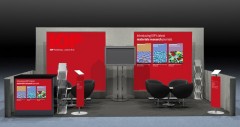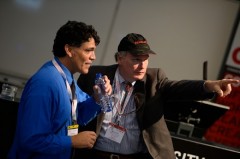Through its flagship COMS event, MANCEF brings together academia and industry to promote the commercialization of micro-, nano- and emerging technologies, and encourage entrepreneurship. This year, the conference was hosted and co-organized by the Center for Engineering Innovation at the University of Utah. In his welcome address, Tom Parks, vice president for research, emphasized that spin-outs are a key part of the university landscape. “Enterpreneurship offers career development for faculty and students,” he explained. “It’s not just about the money, there are longer term benefits.”
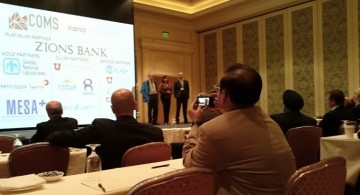
Opening remarks: Steve Walsh (University of New Mexico), Florian Solzbacher (University of Utah) and Maggie Janat-Amsbury (nanoUtah) welcome attendees to COMS 2014
Talking venture capital
As regular attendees to the conference will know, COMS is a practical meeting featuring a mix of talks and Q&A events designed to explore the process of taking a product to market, finding new customers and identifying development partners. Highlights on day one included the investor and venture capital panel discussion chaired by David Blivin of Cottonwood Technology Fund. In the session, funders described what they look for in a start-up and panel members included James Smith, who helped run the CIA’s venture fund dubbed In-Q-Tel.
Smith likes to see start-ups with a clear product definition and a data sheet to go with it. He’s encouraged when founders know who their customers are and have orders on the horizon, which reduces the risk for investors. Even with these points ticked off, uncertainty remains in the ability of an early-stage company to deliver. The panel agreed that a start-up’s technology lead needs to be aware of the different skill sets required for the journey beyond the lab. “It’s unlikely that a founder will take a company from cradle to grave,” commented Todd Stevens of Renewable Tech Ventures, who also sat on the panel. Like many investors he looks not just at the technology, but also at the people leading the project. “Market conditions may change and the management team needs to be able to adapt,” Stevens told the audience. Smith added that it’s important for founders to be self-aware and know their limitations. As the panel highlighted, one way for a firm to expand its expertise is by forming strategic partnerships to help with tasks such as manufacturing scale up and distribution.
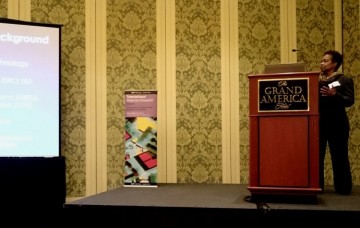
Supporting technology translation: Deborah Jackson of the National Science Foundation (NSF)
Promoting innovation
Spurred on by the theme of the morning plenary session on day two – The new age of materials: why translation matters – given by George Grüner of UCLA, attendees gathered after lunch for the sequel event chaired by the journal Translational Materials Research (TMR). Deborah Jackson of the National Science Foundation (NSF) spoke first on sizing up your innovation ecosystem and pinpointing strengths and weaknesses so that appropriate support can be provided. “We don’t try to apply the silicon valley model across the board,” she explained.
Joining Jackson on the programme were Fiona Jamieson of the Institute of Physics (IOP), who presented key findings on graphene commercialization in the UK and Europe, and Deb Newberry of Nano-Link, who updated on progress being made in upskilling workers for careers involving nanotechnology. To close the popular session, Xiao Zhang of Hitachi High Tehnologies, reported his team’s work on upgrading TEM apparatus to operate under industrially relevant conditions, which he hopes will accelerate the translation of materials discoveries into robust products and devices.
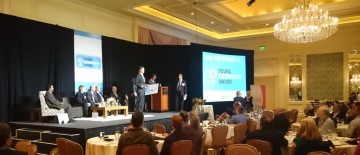
Prize-winning technology: Bernd Vinke of Tide Microfluidics receives both audience and judges prizes at the 2014 Young Technology Award.
Show time
Evening entertainment at COMS includes the Young Technology Award where attendees get to vote on a series of 3 minute pitches given by entrepreneurs attending the conference. This year, the audience and the judging panel were in agreement as Dutch start-up Tide Microfluidics, which has developed a platform for producing highly monodisperse microbubbles for applications in medical imaging and drug delivery, won both prizes and grabbed valuable media attention along the way (see news links and tweets below).
For more information on COMS and for announcements on the 2015 event, visit the MANCEF website.
Related stories –
COMS 2014 big success for local and international researchers (College of Engineering, University of Utah)
Tide Microfluidics grote winnaar van de COMS/Young Technology Award 2014 in Salt Lake City (Powered by Twente)
Related articles from the journal Translational Materials Research (TMR) –
Editorial: Welcome to Translational Materials Research (George Grüner 2014 Transl. Mater. Res. 1 010101)
From the VC desk: striking a balance on focus (Andrew Haughian 2014 Transl. Mater. Res. 1 010202)
Related news on Twitter –




